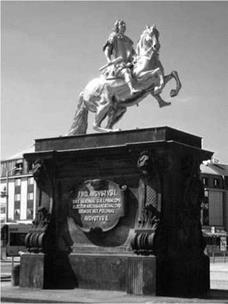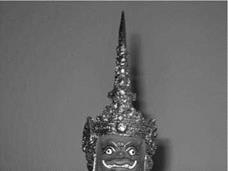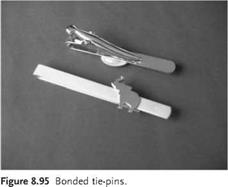When admiring the ‘Golden Horseman’ — an equestrian statue of King August the Strong of Saxonia, which was erected in 1736 on the New City Market (‘Neustadter Markt’) in Dresden, Germany — scarcely anybody realizes that the monument is a miracle of adhesive bonding technology. It was built by layering heated copper over an iron frame, then covered with 0.1 pm-thick gold leaf affixed by so-called ‘gold size’. The statue was refurbished with new gold plate in 1965 which, until 2002, successfully fought against the adverse environmental conditions for almost 40 years, when it was finally regilded (Figure 8.93).
|
Figure 8.93 The monument of ‘August the Strong’ (August der Starke) in Dresden. |
|
Figure 8.94 A gilded statuette from Thailand. |
The Ancient Egyptians were master gilders, who used wax as a binder. ‘Gold size’, which is still used today by restorers of gilded monuments, is a fine coating which consists of polyunsaturated monocarboxylic acids that set by radical polymerization under the effect of oxygen from the air and subsequent auto-oxidation, to produce solid, high-molecular-weight resins. The addition of 1-5% siccatives to the composition (e. g. cobalt, manganese or lead salts of linoleic acid or resin acid) speeds up the slow reaction.
Overlays of gold are found on a wide range of objects, from the golden rims of drinking glasses to the inscriptions on memorial stones. They are also applied, by using a different procedure, to the covers of books, or by the classical gilding method, on statuettes brought home from Asia as souvenirs (Figure 8.94).
When gilding, it is not easy to smoothly lay down the sensitive material over the entire surface, as can be seen in Figure 8.94. Folds that can be seen on the tip of the statuette must not appear on a larger surface. Gilding, as restorers also perform it, is covering a clean and smooth surface with a uniform layer of gold size, and patiently allowing it to ‘dry’ for hours; the gold leaf, which is delivered on tissue paper, is then laid on the gold size without removing the tissue, and gently pressed down. The tissue is then removed from the gold leaf, which is then smoothed out on the gold size with a pad of cotton wool or a very soft, fine brush. It is easily understood that in the majority of cases, the cost of labor is much higher than the value of the gold. For example, a total of 38 g gold (23 carat, corresponding to a purity rate of 99.5%) was laid on August the Strong (1 g of gold is worth D10; gold leaf is worth slightly more).
For adhesion research, gilding has proved to be a phenomenon (see Chapter 3) since, even under adverse conditions, it has a very long life span and provides excellent protection against pitting corrosion on other metals (electroplated gold can only achieve this when a layer 10-20 pm thick is applied). The reason for this is probably that gold size electrochemically ‘decouples’ gold as a noble metal from the common base metal. The shortcomings of gold leaf become evident when it is exposed to mechanical stress because, due to its relatively high purity, it is very soft and has only a low resistance to mechanical wear.
|
|
 22 января, 2016
22 января, 2016  Pokraskin
Pokraskin 


 Опубликовано в рубрике
Опубликовано в рубрике 